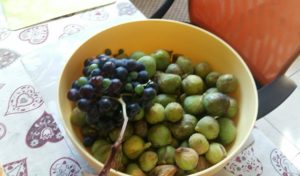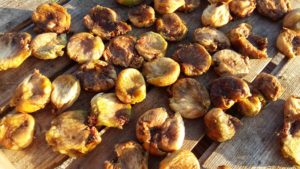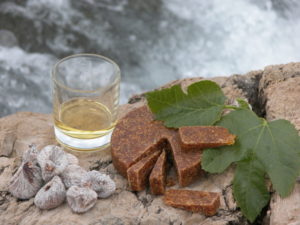Dear Readers,
Welcome to Amerikanka in Croatia, my personal blog! written by an Expat American giving the insider’s view to life in the very popular tourist destination, Croatia. More about me Here.
I write about my findings, some of my experiences and basically want to be a resource for anyone interested in coming to visit or live here.
If you want to save this for later, you can pin it to Pinterest here:
My (free) Cookbook is to say Welcome!
If you would like to receive this newsletter regularly, kindly scroll down to the subscribe option. After that, confirm the email address and you’re in. As a thank you for joining my list of subscribers, I provide you with a personal collection of some of my favorite, tried and true recipes.
Remember that food is a big part of the Croatian experience. It’s nice to bring a package of Franck or Gloria coffee along when you visit a friend, along with a box of cookies.
On the other hand, when you receive guests, it is considered normal to offer freshly baked goods and a freshly brewed cup of coffee (“Turska” / Turkish coffee). We woman in particular cannot usually function without coffee.
Alternatively, if you have a visitor in the late afternoon, many hosts offer “Nes” (Nescafe) to not interfere with anyone’s sleeping patterns.
A shot of homemade liqueur may also be offered if appropriate, or even offer to share a meal with the guest. Croatians really do love food and it is a huge part of how people live and function here.
Fresh or dried figs – nature’s sweets
A nice substitute for the freshly baked goods are dried or fresh figs. They are a real specialty, and worth learning how to prepare, since buying them is quite costly and many producers use sulphur.
I personally reccomend coming here anytime of year, and fall is great, less traffic and lovely weather! (I just checked the weather forecast for September 2016 – only three cloudy days expected and “maybe” one day of sprinkles.)
In my own case, I came in June 1999 – and left in, well, never! With its California-type weather, even the winter months have a pleasant climate and ideal for walking, cycling, and swimming (with a wetsuit).
Autumn is famous for grape harvesting, but figs are equally important. In this age of GMO food, sugar additions and artificial sweeteners, sundried figs are a modern blast from the past.

2016 has turned out to be a bumper crop for figs, and everyone is rejoicing – bees, kids, brandy distillers, and anyone with an organic sweet tooth.
Figs 101. The best figs are sun-ripened, so pick them when they are a bit heavy on their bottoms. If there is a little shining dot on the bottom, they are ripe and sweet as honey.
Watch out for holes – those are bird beak pricks. They like sweet figs too! If they look ok, they are a good candidate for the “brandy brewing bin”.
The ones that fall on the ground under the tree are usually sun ripened, light brownish in color, and if still good (i.e. not muddy or otherwise yucky) can be dusted off and sundried, then ground up into a wonderful cake called HIB. Recipe to follow.
FRESH FIGS (to eat now!)
Choose the nicest of the batch and chill them in the refrigerator (or briefly, in the freezer).
FIG JAM
These are the figs of secondary quality. Maybe they broke open when you picked them, for example. Fig jam consists of chopped up figs, sugar to taste, jam fix if you use it (it helps the jam jell) and a little bit of lemon crystals to keep the color true and attractive looking. A little lemon is usually good to add to any marmelade. Cook until the semi-hard spoon phase and store in heated glass jars, sealing immediately to create a vacuum seal. Here is a fig marmelade recipe 🙂
DRIED FIGS
These are the third class figs. We dry them in the sun, though some people buy a machine that dries them out (see photo). IMHO the sun is best, but it’s great for rainy weather.

Once they are dried in the sun, store them in a cardboard box with bay leaves. Dried figs are traditionally eaten at Christmas time. A verse to the old English Christmas carrol, “We wish you a Merry Christmas” refers to “figgy pudding”. Here in Dalmatia where simplicity rules the figs are just eaten as is, though some people make them into a string necklace (for drying or storing).
HIB
This speciality looks like a cheese round. The figs must be ground (ideally in a metal meat grinder, but a modern mixer is also OK) and mixed with brandy, anise, ground white pepper, and other spices as desired (some people add green and black pepper as well)
2 kilos ground figs
1 cup brandy
fistful of anise (ground up) and 2 teaspoons white pepper.
Mix by hand the formed into a circle mold with bay leaves onto parchment paper. After ten days or so when your hib is sufficiently dry, add bay leaves and a few sprigs of fresh rosemary and seal in cellophane. Now it’s ready to be eaten with coffee, or better yet, with brandy (just a shot plus a slice of Hib) – great for an afternoon delish.

Here is an instructional video for those who like seeing how its done. It’s in Croatian but the visual helps.


















 Hello everyone!
Hello everyone!
Recent Comments